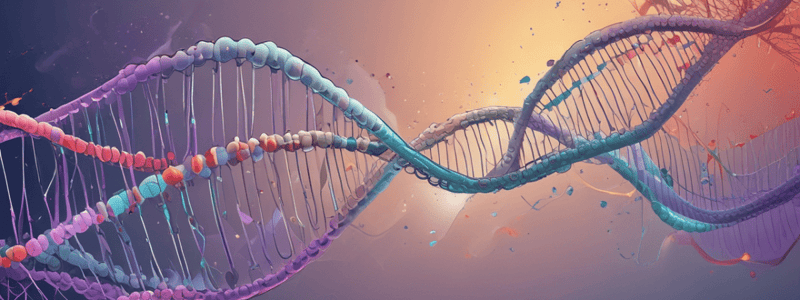Podcast
Questions and Answers
What is the primary function of ATP-dependent enzymes in chromatin remodeling?
What is the primary function of ATP-dependent enzymes in chromatin remodeling?
- To establish DNA methylation patterns
- To phosphorylate histone proteins and activate gene expression
- To compact chromatin structure and inhibit transcription
- To disrupt histone-DNA interactions and reposition nucleosomes (correct)
Which of the following mechanisms is involved in the demethylation of DNA?
Which of the following mechanisms is involved in the demethylation of DNA?
- Passive demethylation through cell division
- Transcription factor binding to specific DNA sequences
- Histone acetylation and chromatin remodeling
- Active demethylation through TET enzyme-mediated oxidation (correct)
How can transcription factors be regulated in eukaryotes?
How can transcription factors be regulated in eukaryotes?
- Only through protein-protein interactions and localization
- Only through DNA methylation and histone modification
- Through various mechanisms, including post-translational modifications, protein-protein interactions, localization, and binding of co-factors or chromatin remodeling complexes (correct)
- Only through post-translational modifications, such as phosphorylation
What is the primary mechanism of epigenetic inheritance in eukaryotes?
What is the primary mechanism of epigenetic inheritance in eukaryotes?
What is the function of histone deacetylases (HDACs) in eukaryotes?
What is the function of histone deacetylases (HDACs) in eukaryotes?
What is the result of ubiquitination of histone proteins in eukaryotes?
What is the result of ubiquitination of histone proteins in eukaryotes?
Flashcards are hidden until you start studying
Study Notes
Transcription Regulation in Eukaryotes
Chromatin Remodeling
- Involves reorganization of chromatin structure to facilitate or inhibit transcription
- ATP-dependent enzymes, such as SWI/SNF and RSC, disrupt histone-DNA interactions and reposition nucleosomes
- Chromatin remodeling complexes can be recruited by transcription factors to specific genomic regions
- Can also be involved in the repression of transcription by compacting chromatin
DNA Methylation
- Involves the addition of a methyl group to cytosine residues in CpG dinucleotides
- Typically associated with gene silencing, particularly in promoter regions
- DNA methyltransferases (DNMTs) are responsible for establishing and maintaining DNA methylation patterns
- Demethylation can occur through passive or active mechanisms, including TET enzyme-mediated oxidation
Transcription Factor Regulation
- Transcription factors bind to specific DNA sequences to regulate gene expression
- Can act as either activators or repressors of transcription
- Transcription factors can be regulated by various mechanisms, including:
- Post-translational modifications (e.g., phosphorylation, acetylation)
- Protein-protein interactions
- Localization and nuclear import
- Binding of co-factors or chromatin remodeling complexes
Epigenetic Inheritance
- Refers to the transmission of epigenetic marks from parent to daughter cells
- Involves the maintenance of chromatin structure and epigenetic modifications during cell division
- Histone modifications and DNA methylation can be inherited through mitosis and meiosis
- Epigenetic inheritance can influence gene expression and cellular differentiation
Histone Modification
- Involves the covalent modification of histone proteins to alter chromatin structure and accessibility
- Modifications include:
- Acetylation (activation mark)
- Methylation (activation or repression mark)
- Phosphorylation (activation mark)
- Ubiquitination (repression mark)
- Sumoylation (repression mark)
- Histone modifications can be recognized by specific binding proteins, which recruit chromatin remodeling complexes or transcription factors
- Histone modifications can also be erased by specific enzymes, such as histone deacetylases (HDACs)
Studying That Suits You
Use AI to generate personalized quizzes and flashcards to suit your learning preferences.



